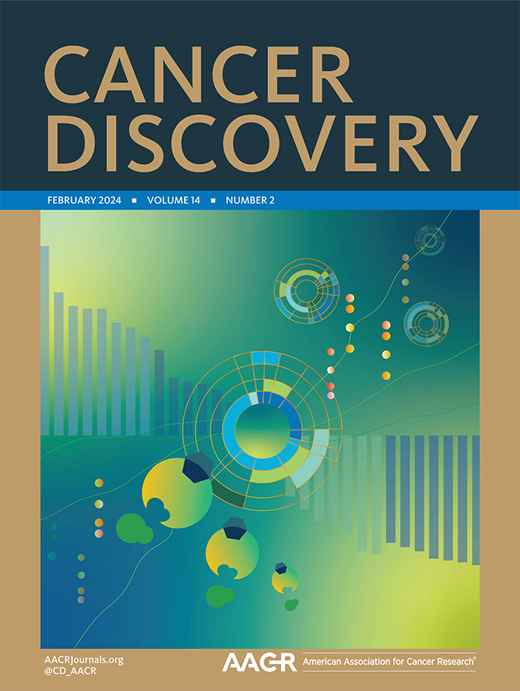细胞毒性NK细胞阻碍免疫排除表型黑色素瘤对检查点免疫治疗的反应
IF 29.7
1区 医学
Q1 ONCOLOGY
引用次数: 0
摘要
免疫检查点阻断(ICB)已经彻底改变了癌症治疗。不幸的是,淋巴细胞无法浸润肿瘤巢,这种现象被称为免疫排斥,极大地限制了ICB的反应性。通过分析接受ICB治疗的黑色素瘤患者治疗前和治疗早期活检的免疫情况,我们观察到在治疗早期无反应的活检中细胞毒性NK细胞显著增加。空间多组学分析显示,尽管NK细胞与CD8+ T细胞在应答病变的肿瘤床内共定位,但它们在无应答病变的肿瘤实质中被排除在外。引人注目的是,在一种独特的黑色素瘤小鼠模型中,NK细胞的药理学耗竭显示出免疫排斥表型,释放了肿瘤核心的免疫浸润和ICB暴露后的肿瘤清除。在机制上,我们发现NK细胞通过趋化因子受体CX3CR1在ICB暴露后积极招募到免疫排斥区域,以抑制CD8+ T细胞的肿瘤浸润和抗肿瘤功能。意义:免疫排斥是约一半无应答患者对ICB产生内在耐药的原因。我们意外地观察到,靶向NK细胞生物学释放CD8+ T细胞在免疫排斥表型肿瘤中的募集和抗肿瘤活性,为这一庞大的患者群体提供了潜在的治疗途径。参见宋等的相关文章,第XX页本文章由计算机程序翻译,如有差异,请以英文原文为准。
Cytotoxic NK Cells Impede Response to Checkpoint Immunotherapy in Melanoma with an Immune-Excluded Phenotype
Immune checkpoint blockade (ICB) has revolutionized cancer treatment. Unfortunately, the inability of lymphocytes to infiltrate the tumor nest, a phenomenon known as immune exclusion, drastically limits ICB responsiveness. Analyzing the immune landscape of matched pre- and early on-treatment biopsies of patients with melanoma undergoing ICB therapy, we observed a significant increase in cytotoxic NK cells in early on-treatment biopsies from nonresponders. Spatial multiomic analyses revealed that, although NK cells colocalized with CD8+ T cells within the tumor bed in responding lesions, they were excluded from the tumor parenchyma in nonresponding lesions. Strikingly, pharmacologic depletion of NK cells in a unique melanoma mouse model exhibiting an immune-excluded phenotype unleashed immune infiltration of the tumor core and tumor clearance upon ICB exposure. Mechanistically, we show that NK cells are actively recruited to immune-excluded areas upon ICB exposure via the chemokine receptor CX3CR1 to suppress tumor infiltration and antitumor function of CD8+ T cells. Significance: Immune exclusion is responsible for intrinsic resistance to ICB in about half of nonresponder patients. Our unexpected observation that targeting NK cell biology unleashes the recruitment and antitumor activity of CD8+ T cells in tumors with an immune-excluded phenotype offers a potential therapeutic avenue for this large patient population. See related article by Song et al., p. XX
求助全文
通过发布文献求助,成功后即可免费获取论文全文。
去求助
来源期刊

Cancer discovery
ONCOLOGY-
CiteScore
22.90
自引率
1.40%
发文量
838
审稿时长
6-12 weeks
期刊介绍:
Cancer Discovery publishes high-impact, peer-reviewed articles detailing significant advances in both research and clinical trials. Serving as a premier cancer information resource, the journal also features Review Articles, Perspectives, Commentaries, News stories, and Research Watch summaries to keep readers abreast of the latest findings in the field. Covering a wide range of topics, from laboratory research to clinical trials and epidemiologic studies, Cancer Discovery spans the entire spectrum of cancer research and medicine.
 求助内容:
求助内容: 应助结果提醒方式:
应助结果提醒方式:


